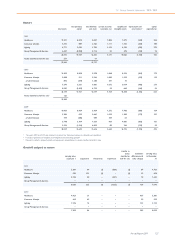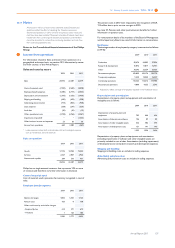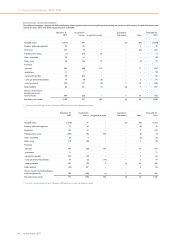Philips 2011 Annual Report Download - page 135
Download and view the complete annual report
Please find page 135 of the 2011 Philips annual report below. You can navigate through the pages in the report by either clicking on the pages listed below, or by using the keyword search tool below to find specific information within the annual report.
12 Group financial statements 12.10 - 12.10
Annual Report 2011 135
of assets/liabilities held for sale, even though the associated item in the
Statement of Income would be presented as part of discontinued
operations. The presentation of cash flows relating to such items in that
case mirrors the classification in the Statement of Income, i.e. as cash
flows from discontinued operations.
Adjustments in the current period to amounts previously presented in
discontinued operations that are directly related to the disposal of a
discontinued operation in a prior period are classified separately in
discontinued operations. Circumstances to which these adjustments
may relate include resolution of uncertainties that arise from the terms
of the disposal transaction, such as the resolution of a purchase price
adjustments and indemnifications, resolution of uncertainties that arise
from and are directly related to the operations of the component
before its disposal, such as environmental and product warranty
obligations retained by the Company, or the settlement of employee
benefit plan obligations provided that the settlement is directly related
to the disposal transaction.
Segments
Operating segments are components of the Company’s business
activities about which separate financial information is available that is
evaluated regularly by the chief operating decision maker (the Board of
Management of the Company). The Board of Management decides how
to allocate resources and assesses performance. Reportable segments
comprise the operating sectors: Healthcare, Consumer Lifestyle,
Lighting, and, until 2011, the Television business which was part of
Consumer Lifestyle. Segment accounting policies are the same as the
accounting policies as applied to the Group. Segment reporting
comparatives are reclassified for profit or loss purposes, so it is no
longer mentioned for the Television business.
Cash flow statements
Cash flow statements are prepared using the indirect method. Cash
flows in foreign currencies have been translated into euros using the
weighted average rates of exchange for the periods involved. Cash
flows from derivative instruments that are accounted for as fair value
hedges or cash flow hedges are classified in the same category as the
cash flows from the hedged items. Cash flows from other derivative
instruments are classified consistent with the nature of the instrument.
Earnings per share
The Company presents basic and diluted earnings per share (EPS) data
for its common shares. Basic EPS is calculated by dividing the net income
attributable to shareholders of the Company by the weighted average
number of common shares outstanding during the period, adjusted for
own shares held. Diluted EPS is determined by adjusting the Statement
of income attributable to shareholders and the weighted average
number of common shares outstanding, adjusted for own shares held,
for the effects of all dilutive potential common shares, which comprise
convertible personnel debentures, restricted shares and share options
granted to employees.
Financial guarantees
The Company recognizes a liability at the fair value of the obligation at
the inception of a financial guarantee contract. The guarantee is
subsequently measured at the higher of the best estimate of the
obligation or the amount initially recognized.
Accounting changes
In the absence of explicit transition requirements for new accounting
pronouncements, the Company accounts for any change in accounting
principle retrospectively.
Reclassifications
Certain items previously reported under specific financial statement
captions have been reclassified to conform to the current year
presentation.
IFRS accounting standards adopted as from 2011
The accounting policies set out above have been applied consistently
to all periods presented in these Consolidated financial statements
except as explained below which addresses changes in accounting
policies.
The Company has adopted the following new and amended IFRSs as of
January 1, 2011.
Improvements to IFRSs 2010
In May 2010, the IASB issued ‘Improvements to IFRSs 2010‘, a collection
of amendments to seven International Financial Reporting Standards, as
part of its program of annual improvements to its standards, which was
intended to make necessary, but non-urgent, amendments to standards
that are not included as part of another major project. The
amendments resulting from this standard mainly have effective dates
for annual periods beginning on or after January 1, 2011. The
improvements did not have a material impact on the Company’s
Consolidated financial statements.
Revised IAS 24 ‘Related Parties Disclosures’
The revised standard simplifies the definition of a related party,
clarifying its intended meaning and eliminating inconsistencies from the
definition. The Company applied IAS 24 (revised) retrospectively from
January 1, 2011. The change in accounting policy impacted disclosures
only.
Amendment to IAS 32 ‘Classification of Rights Issues’
The amendment addresses the accounting for rights issues (rights,
options or warrants) that are denominated in a currency other than
the functional currency of the issuer. Previously, such rights issues were
accounted for as derivative liabilities. The amendment requires that,
provided certain conditions are met, such rights issues are classified as
equity regardless of the currency in which the exercise price is
denominated. This amendment was applied by the Company on January
1, 2011 and did not have a material impact on the Company’s
Consolidated financial statements.
Amendment to IFRIC 14 ‘Prepayments of a Minimum Funding Requirement’
This amendment allows for the recognition of an asset for any surplus
arising from the voluntary prepayment of minimum funding
contributions for defined-benefit plans in respect of future service. The
amendment to IFRIC 14 was adopted on January 1, 2011, was applied
retrospectively and did not have a material impact on the Company’s
Consolidated financial statements.
IFRIC 19 ‘Extinguishing Financial Liabilities with Equity Instruments’
IFRIC 19 clarifies the accounting when the terms of debt are
renegotiated with the result that the liability is extinguished by the
debtor issuing its own equity instruments to the creditor (referred to
as a ‘debt for equity swap’). The interpretation requires a gain or loss
to be recognized in Statement of income when a liability is settled
through the issuance of the entity’s own equity instruments. The
reclassification of the carrying value of the existing financial liability into
equity (with no gain or loss being recognized in Statement of income)
is no longer permitted. IFRIC 19 was applied on January 1, 2011 and
with retrospective effect. The application of this IFRIC did not have a
material impact on the Company’s Consolidated financial statements.
IFRS accounting standards adopted as from 2012 and onwards
The following standards and amendments to existing standards have
been published and are mandatory for the Company beginning on or
after January 1, 2012 or later periods, and the Company has not yet
early adopted them:
IAS 1 ‘Presentation of financial statements’ (2011 amendment)
The new amendment requires separation of items presented in OCI
into two groups, based on whether or not they can be recycled into
the Statement of income in the future. Items that will not be recycled
in the future are presented separately from items that may be recycled
in the future. The amendment will be adopted on January 1, 2013 and
will be applied retrospectively. However, the amendment has not yet
been endorsed by the EU. The application of this amendment impacts
presentation and disclosures only.
IAS 19 ‘Employee benefits’
The revisions to IAS 19 are effective for annual periods beginning on
or after January 1, 2013, but have not yet been endorsed by the EU. In
general, the amendment no longer allows for deferral of actuarial gains
and losses or cost of plan changes and it introduces significant changes
to the recognition and measurement of defined benefit pension
expenses and their presentation in the Statement of income. Additional
disclosure requirements have been added for risks and plan objectives
























